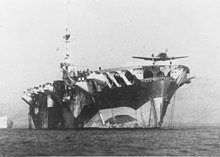HMS Pretoria Castle (F61)
This article needs additional citations for verification. (October 2020) |
 HMS Pretoria Castle
| |
| History | |
|---|---|
| Name | Pretoria Castle |
| Port of registry | |
| Builder | Harland & Wolff |
| Yard number | 1006[1] |
| Launched | 12 October 1938 |
| Completed | 18 April 1939[1] |
| Identification |
|
| Fate | Requisitioned for Royal Navy October 1939 |
| Name | HMS Pretoria Castle |
| Commissioned | 28 November 1939 |
| Decommissioned | August 1942 |
| Refit | Converted from armed merchant cruiser to escort carrier |
| Identification | Pennant number F61 |
| Commissioned | 29 July 1943 |
| Decommissioned | 26 January 1946 |
| Fate | Sold back to the Union-Castle Line 1946 |
| Name | RMMV Warwick Castle |
| Port of registry | |
| Acquired | 1946 |
| Fate | Scrapped July 1962 |
| General characteristics | |
| Type | Ocean liner |
| Tonnage | 17,392 GRT |
| Displacement | 23,450 tons |
| Length | 594 ft (181.1 m) |
| Beam | 76 ft (23.2 m) |
| Draught | 29 ft (8.8 m) |
| Installed power | 16,000 bhp (12,000 kW); 3,284 NHP |
| Propulsion | Diesel engines, twin screw |
| Speed | 18 knots (33 km/h; 21 mph) |
| Aircraft carried | 21 |
HMS Pretoria Castle (F61) was a Union-Castle ocean liner that in the Second World War was converted into a Royal Navy armed merchant cruiser, and then converted again into an escort carrier. After the war she was converted back into a passenger liner and renamed Warwick Castle.
History

In July 1942 the Admiralty bought her outright for conversion to an escort carrier by Swan Hunter on Tyneside. For her new role her armament included ten Oerlikon 20 mm cannon.[3] She was commissioned in her new role in July 1943. She operated as a trials and training carrier, seeing no active combat service.
In 1945 she twice became part of aviation history, firstly when British
After the war the ship was sold back to the Union-Castle Line in 1946 and converted back to a passenger liner, restored to its route between England and South Africa but renamed Warwick Castle. She was sold and scrapped in Barcelona in July 1962.
Notes
- ^ ISBN 978-0752488615.
- ^ Lloyd's Register of Shipping (PDF). London: Lloyd's Register. 1939. Retrieved 8 October 2020.
- ^ "HMS Pretoria Castle Gun 10 X BR 20mm 70cal Mark V VC Power Twin". NavHist. Flixco Pty Limited. Retrieved 8 October 2020.
- ^ Mason, Geoffrey B. "HMS Pretoria Castle (F 61) – Escort Aircraft Carrier". Service Histories of Royal Navy Warships in World War 2. Naval History. Retrieved 27 February 2016.
References
- Osborne, Richard; Spong, Harry & Grover, Tom (2007). Armed Merchant Cruisers 1878–1945. Windsor, UK: World Warship Society. ISBN 978-0-9543310-8-5.
Further reading
- Brown, Eric. Wings of the Weird and Wonderful.[clarification needed]
- ISBN 978-1407244518.[page needed]
External links
![]() Media related to HMS Pretoria Castle (F61) at Wikimedia Commons
Media related to HMS Pretoria Castle (F61) at Wikimedia Commons
- Drury, Tony. "A history of HMS Pretoria Castle". Royal Navy Research Archive.
- Helgason, Guðmundur. "HMS Pretoria Castle (F 61)". uboat.net.
- "UK/Union Castle". The Late, Great Ocean Liners. Archived from the original on 17 March 2006.
